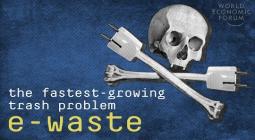Business strategies for cost-saving circular economy solutions.

Circular economy principles offer compelling strategic and operational benefits for the manufacturing industry. These include substantial cost savings, which companies should take advantage of, writes Rafael Go.
Rafael Go is a senior research analyst contributing to Navigant Research’s best practices research.
For example, Dell has incorporated recycled plastics into its products, using the world’s largest takeback program of used electronics. Dell’s cloud service lines provide customers with computing capabilities while eliminating the need for physical assets, reducing costs and carbon footprints.
Companies that adopt circular economy practices can also extract additional value from leakages or waste in the production process.
Although many circular economy initiatives incorporate cutting-edge technology and new business models and processes, the initial steps that manufacturing companies should take to adopt this approach are centred around effective communication and goal-setting.
A recent Navigant report outlines potential business strategies and practices that manufacturing companies can adopt and provides recommendations for companies venturing into this area.
Map resource and waste flows
Given the large emphasis on reducing material leakages, energy use, and waste generation, manufacturing companies seeking to adopt circular economy principles should develop a solid understanding of resource use and waste generation within their current business processes.
Using techniques such as resource flow maps will enable companies to develop a better understanding of current resource and energy needs and identify potential areas of improvement, helping to set priorities. Resource maps can also pinpoint crucial dependencies throughout the supply chain, aiding risk management efforts.
Gaining knowledge of current resource use can facilitate the creation of sustainability goals by providing a baseline and informing the formulation of feasible targets.
Navigant offers services including design optimisation, lifecycle assessment analysis, footprinting and reporting, material and energy efficiency, and waste management analysis to help businesses create a circularity scorecard to map the performance of products or clients.
Establish tone from the top
The circular economy represents a significant change from current norms. Combining the various operational and process changes necessary to implement these practices with the multitude of pathways and initiatives that manufacturing companies can undertake requires discipline, effective goal-setting, and change management practices.
To actualise these principles, leadership should lend substantial and unified support, actively communicating its support to the rest of the organisation. Extensive support from leadership is crucial to win the hearts and minds within the organisation and to implement these initiatives effectively.
More importantly, demonstrating strong leadership support enables the implementation of circular economy practices while combating strong pressures from stakeholders, including investors and consumers.
Given potential backlash from stakeholders regarding the transformational change attributed to the circular economy, strong commitment from leadership provides a license to operate in the face of these pressures, enabling the business to confidently evaluate and implement potentially new revenue streams from circular business models such as sharing platforms and product as a service.
Engage business partners and stakeholders
Manufacturing companies should also reorient their relationships with supplier partners and customers to effectively implement circular economy solutions throughout the product lifecycle. Product designers working with supply chain partners can ensure that materials are sourced and used as sustainably as possible or incorporate greener alternative materials.
Besides communicating the importance of circularity with partners throughout the supply chains, companies can lean on supply chain partners that may have more expertise in recycling various key material inputs at the end of life.
For example, Borealis, an Austrian chemicals and plastics group, partnered with equipment manufacturer Lindner to develop new processes to recycle and reuse plastics in its products.
Circular economy solutions can be used as a great marketing tool for attracting new clients, so marketing and sales teams will need to be trained to fluently discuss the benefits of these solutions to customers.
Furthermore, companies will need to create new customer engagement practices as products become increasingly repurposed at end of life or continuously serviced to extend their use.
Circular economy solutions represent a great opportunity for manufacturing companies to take advantage of changing customer preferences, regulatory environments, and cutting-edge technologies.
Adopting these solutions helps manufacturing companies improve operational efficiencies, reduce costs, and realise strategic benefits such as increased product innovation, improved risk mitigation, and reduced carbon footprints.
However, as the circular economy seeks to fundamentally change how products are created and consumed, manufacturing companies will have to rethink their operations and strategy to effectively implement these solutions.
Improving their understanding of how the business uses resources and generates waste, demonstrating and communicating commitment, and reorienting relationships with partners and customers are crucial first steps that manufacturing companies should take when adopting circular economy solutions.
8 January 2020
Euractiv



